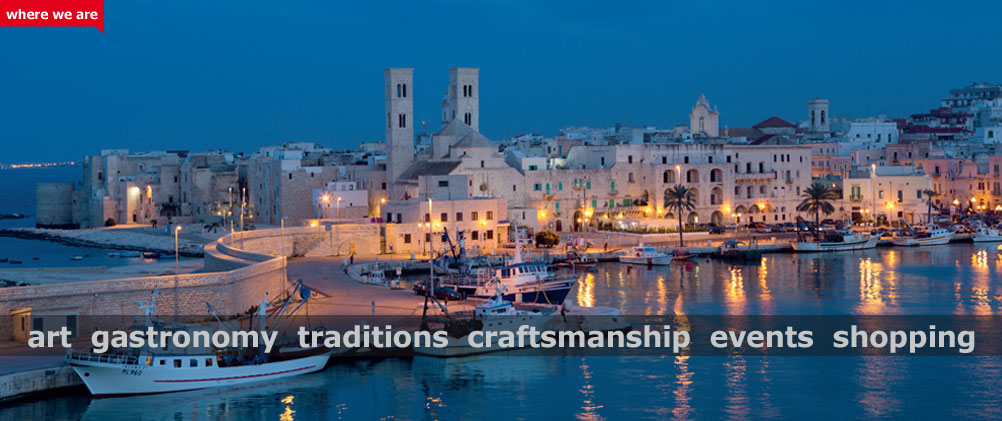ANCIENT CENTER. The medieval center is located on the peninsula known as di Sant’Andrea [St. Andrew's peninsula], named after the ancient church, mentioned for the first time in notarial documents in 1126. The local tradition, which traces Molfetta’s origins to the Greek -Roman age, has no documentary support. The sources dating back to the tenth or eleventh century, offer an image of a village where there are already several churches, which is surrounded by walls on the south and on north, on the sea, from a palace structure, an interesting defensive-living system whose structure is still visible. A series of parallel streets develop in east-west direction and connects with the two poles of the Duomo and the site of the Castle (destroyed in 1416), the current Piazza Municipio [Town Hall Square]. This road network is cut in a north - south direction by via Piazza, the main street of the ancient center, as a result of the gradual building development that, between the eleventh and seventeenth centuries, occurred in the platea, the ancient widening described by the documents. The most significant palaces, mostly located along the perimeter of the village, date back after 1529, the year of the French Sack, which produced considerable damage to the architectural and documentary heritage of the town. It is recommended to access the ancient town through the Gate that opens in Corso Dante.
Via Amente: it is characterized by the presence of various noble palaces dating from the sixteenth and seventeenth centuries, leaning against the surrounding walls in a compact structure. In the buildings the more interesting elements are the finely decorated portals, the porches with large staircases, the loggias, the fine wells. Worth visiting are at n. 10 the de Luca palace, at n.14 the Tattoli palace, at n. 32 the Passari Lupis palace, at n. 48 the Monna palace.
Piazza Municipio: the ancient square of the Castle. We recommend the Renaissance façade of Palazzo Giovene [Giovene Palace] , now the town hall, the intact medieval room of the Sala dei Templari [Templars’ Hall] , the remains of the properties of the Chiesa di San Nicolò [Church of St. Nicholas] of the “Casa del Tempio” [House of the Temple].
Via San Pietro: worth visiting is the seventeenth-century chiesa di San Pietro [church of St. Peter] with the tall bell tower, which was built on the existing medieval church (inside there are some paintings of the Giaquinto school); it is flanked by the massive structure of the sixteenth-century convent of Benedictine nuns.
Via Sant'Orsola: on the north side the ancient palace structure on the sea can be identified by the compactness of the buildings. Even in this street there are several noble palaces with rich and decorated entrance halls. At number 13, Galante Gadaleta Palace, you can enter the Passari Tower , a seventeenth-century cylindrical fortification with which the defensive structures of the town were straightened to make it resistant against the newly created firearms: the tower for the defence of the town was built "in the area of the Passaro sea"; Passari is the name of the powerful family who lived in the nearby seaside palaces.
Via Piazza: this is the largest and the most lively street of the ancient center. You can access it through the large arch of the Porta della Città [Gate of the City] , the only remains of the medieval fortified walls; the large stone pillars are still intact. In front of the arch of via Forno, in the small widening, there was the Seat of the People's Party, of which there are no remains, and the Seat of the Nobles at numbers 10 and 12 (it is testified by the wall arches and the coat of arms of the Town surmounted by the image of the Madonna dei Martiri [Our Lady of Martyrs], who is the patron saint of Molfetta. It is recommended to visit the ancient chiesetta di S. Andrea [small church of St Andrea] dating back to the twelfth century and refurbished in the seventeenth and eighteenth centuries.
Vico Muro: narrow street which connects with the panoramic walk on the ancient walls of the ancient town.
THE MOLFETTA WALLS . Molfetta appears for the first time in documents of the tenth or eleventh century. It was locked by the walls on the south and on the north by the "litus maris" on which the tall, narrow houses stood as a barrier, thus making up the facade structure which is typical of many Adriatic towns. The south walls were marked by several bastions that followed one another regularly. In the sixteenth century the main gate was topped by the clock tower which was later demolished, the smaller one, called "Porticella" [Small Gate] that was close to today's Piazza Municipio [Town Hall Square], was destroyed at the end of the nineteenth century. In the first two decades of the sixteenth century, the construction of the Passari Tower responded to the need to protect the building belt on the sea with guns. In the seventeenth century the medieval walls exhausted their defensive function as the city began to expand, and at the end of the eighteenth century the Town University authorized the emptying of the embankment in the walls body to get the workshops that were to adorn the "street of the village".
|







